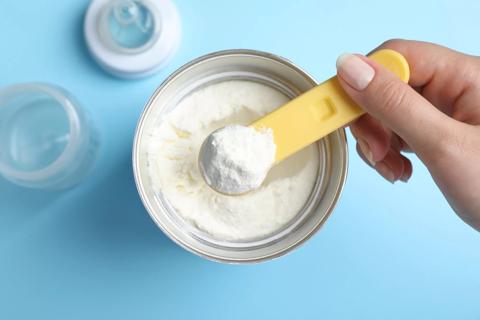Typically, milk comes in a few days after birth and regulates around four weeks after delivery

Breastfeeding (chestfeeding) can be one of the most natural things your body does. But it can be difficult at times. And it can feel shrouded in mystery.
Advertisement
Cleveland Clinic is a non-profit academic medical center. Advertising on our site helps support our mission. We do not endorse non-Cleveland Clinic products or services. Policy
Somehow, your breasts go from these things that are just ... there ... to the very tools that you’re using day and night to keep your baby healthy.
But how does that happen? When does your milk “come in”? How does milk supply get established? When does your breast milk supply regulate? And how do you know if you’re making enough milk?
These are common and valid questions.
“It’s very natural for people who are breastfeeding to worry about their milk supply and want to know what’s going on in their bodies,” says Kam Lam, MD, a breastfeeding medicine physician. “The first few weeks of breastfeeding are very important to setting the stage for establishing a healthy milk supply that will nourish your baby.”
We talked with Dr. Lam about what you need to know about your milk supply so you can know what to expect.
When milk will come in, how much milk will be made and how well breastfeeding will go can vary from person to person.
But as a general timeframe, you can expect that your milk supply will increase substantially in the first two weeks and will be established by about four weeks after delivery.
“Milk supply can be a finicky thing,” Dr. Lam reports. “Lactation is affected by a lot of things, like how often you nurse, how well the baby latches, your health and more. So, it’s important to recognize that your experience may be different from other people you talk with.”
Advertisement
But typically, your body will begin the process of producing breastmilk during the second trimester of your pregnancy and continue to make milk for as long as your baby needs it.
Here’s a general idea of what to expect:
Your body starts gearing up to breastfeed long before you even give birth. That’s usually around week 16 of your pregnancy.
“You may feel a little more fullness in your breasts around that time and may even have a bit of leaking in the third trimester,” Dr. Lam says.
This is called “stage one lactogenesis.” It’s essentially a time when your body begins to make milk to feed your baby.
During this stage, you’ll begin making colostrum. Colostrum is the first kind of milk you’ll make. It’s highly concentrated and full of nutrients, antioxidants and antibodies that will build your baby’s immune system in their first few days of life. Colostrum is thicker than milk and has a yellowish color.
During your second and third trimester, you may notice some other changes to your breasts to get ready for breastfeeding, too, like:
In the first few days after delivering your baby, you’ll continue to make colostrum. And then, a switch will come. Some people refer to this as their milk “coming in.” Your healthcare teams call it “second-stage lactogenesis.” And it typically happens between two and seven days after delivery.
Some people will notice the change from colostrum to milk because it can cause some discomfort in the breasts. This is called breast engorgement, and it could make your breasts feel tender, swollen, full, hard and even painful. You also may leak milk when your milk comes in.
While it might feel like something is “off,” it’s natural to experience mild engorgement when your milk comes in. It’s a good sign that your milk supply is becoming established.
“Mild engorgement is a normal physiological process to making breastmilk, but it can be quite surprising, especially for people who are lactating for the first time,” Dr. Lam reassures. “It typically lasts a few days, up to about a week. As your body starts to recognize how much milk you need, it starts to level out.”
Severe engorgement should be managed by a lactation consultant to investigate underlying causes and ensure it doesn’t progress to mastitis or cause a drop in your supply.
You can help to calm down the discomforts of mild engorgement by:
Advertisement
Again, everyone’s body is different. You may feel the effects of engorgement when your milk comes in. You may not. And it may take your milk longer to make the change from colostrum. Some factors that can delay the transition from colostrum to milk include:
After that initial rush of milk coming in, your body starts to operate a little differently. Your milk supply becomes established based on supply and demand and relies less on hormones.
How?
As your baby nurses (and/or you pump milk), your body takes notice. It recognizes how much you use each day to feed your baby, and it adjusts accordingly. It’s less likely now to overproduce and fill your breasts to the point of pain or discomfort. But you’ll make enough to keep your baby healthy.
This is the third and final stage of lactogenesis. It’s the sweet spot of breastfeeding when your body becomes in tune with baby’s needs.
Advertisement
It’s at this point where you might consider your milk supply “regulated.” But remember that even an established milk supply is a moving target.
“I like to say, The baby makes the milk. Because after your milk comes in, breastfeeding works on the principles of supply and demand,” Dr. Lam explains. “As you remove milk from the breast, your body makes more to keep up with baby’s needs.”
In other words, the more milk you use, the more you’ll make. And vice versa. So it’s important to your supply that you remove the milk you need. Not more. Not less.
Dr. Lam offers these tips for establishing and maintaining your milk supply:
Advertisement
How will you know that your milk supply is regulated? (And that your baby is getting what they need?) Dr. Lam suggests looking for these signs that your breast milk has regulated and is meeting your baby’s needs:
If you’re worried about your breastmilk supply, you’re far from alone. It’s not easy to spot what’s going on inside of your breasts after all.
Dr. Lam advocates for reaching out to a healthcare professional, like a lactation consultant or breastfeeding medicine physician, early if you have any questions or concerns.
“The earlier the intervention, the better. The first few days and weeks of breastfeeding are critical for establishing a healthy supply, so getting the support you need early on can make a big difference in successful breastfeeding.”
Learn more about our editorial process.
Advertisement

When breastfeeding doesn’t go as planned, you may need to supplement with formula or donor breast milk — and that’s OK

Breastfeeding supplements can be a needless expense at best, and risky at worst

From the football hold to the cradle hold, consider trying a variety of techniques

Gentle massaging, lying on your side and hand-expressing a little milk can help

Get your milk flowing by getting comfy, releasing stress and focusing on your baby

Popular myth says breastfeeding prevents pregnancy, but that’s not the whole story

With some exceptions, most are OK

Removing the piercing as early as possible is important for avoiding complications

Type 2 diabetes isn’t inevitable with these dietary changes

Applying a hot or cold compress can help with pain